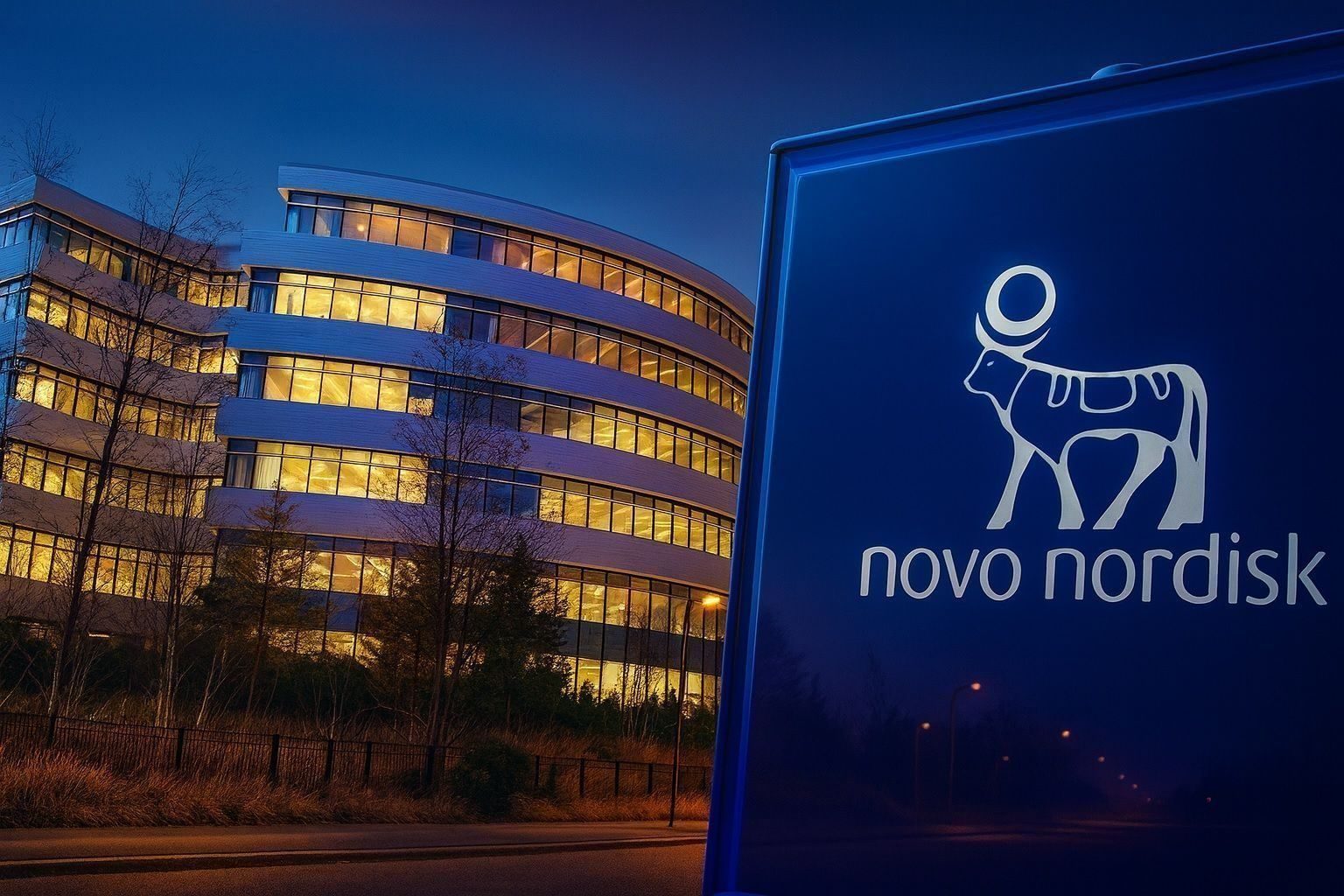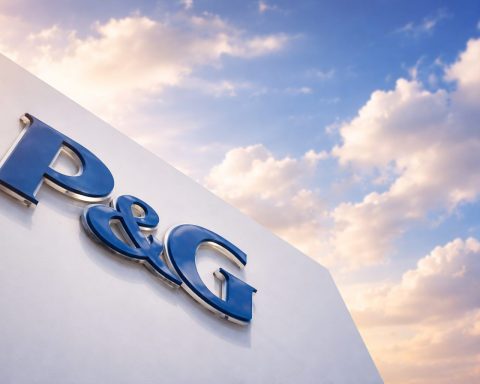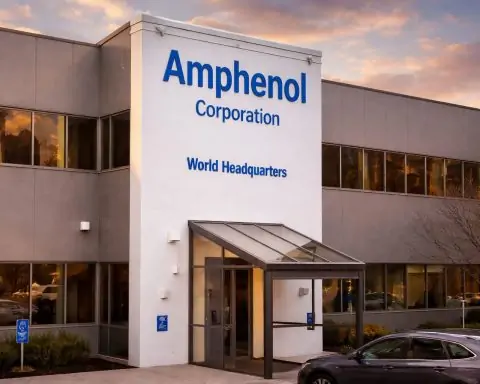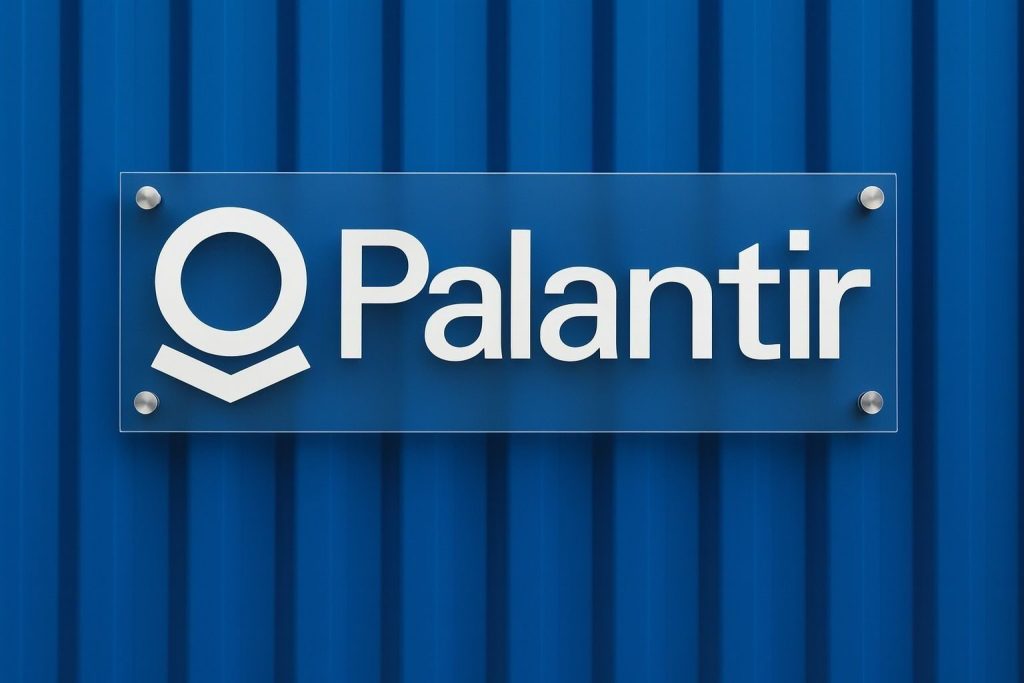Novo Nordisk (NYSE: NVO) shares are trying to stabilise after a bruising November as fresh obesity‑drug data, a higher‑dose Wegovy filing and new analyst calls collide with lingering worries about growth and competition.
1. How Novo Nordisk stock is trading today
Novo Nordisk’s U.S.-listed ADRs are changing hands around $49.25, up roughly 1% on the day, after trading between $48.35 and $49.75 in Friday’s session. Intraday volume is a little over 6.7 million shares, in line with recent elevated activity.
On its home market in Copenhagen, Novo’s B‑shares closed near 317 DKK, up about 2% on the day but still down roughly 49% year to date, according to MarketScreener data. [1]
Even after today’s bounce, the stock sits near a multi‑year low and far below its 12‑month peak above $110, leaving NVO down around 45–50% in 2025 depending on the index you use. [2]
Valuation has compressed sharply: MarketBeat pegs Novo Nordisk at a price/earnings ratio of ~13.4, with a market cap around $218 billion, versus the premium multiple it commanded at the height of the GLP‑1 boom. [3]
For investors, the big question today is whether the latest news flow—analyst moves, pipeline data and corporate governance updates—marks the start of a turnaround or just a pause in the sell‑off.
2. The headline move: Goldman Sachs cuts target but stays bullish
The most market‑relevant news on 28 November 2025 is a fresh note from Goldman Sachs:
- Goldman lowered its 12‑month price target on NVO from $60 to $54.
- Crucially, it maintained a “Buy” rating on the stock. [4]
Goldman’s new target implies roughly 10–11% upside from current levels, depending on which timestamped price you use. [5]
Other key analyst context around NVO right now:
- BMO Capital recently cut its target from $50 to $46 and rates the stock “Market Perform”. [6]
- HSBC moved from “Buy” to “Hold” earlier this week. [7]
- Consensus across a broader set of analysts still sits around $54–57 per ADR, with a “Buy” or “Hold” leaning overall and a target range roughly $46–$70. [8]
In plain English: Wall Street has cooled on Novo Nordisk, but hasn’t given up. Targets are drifting lower, yet most analysts still see double‑digit percentage upside from here, provided the company can stabilise GLP‑1 growth and deliver on its new obesity pipeline.
3. Pipeline spotlight: amycretin gives investors “huge news”
A second major theme in today’s coverage is amycretin, one of Novo Nordisk’s most important next‑generation obesity/diabetes candidates.
Although the company released the core data on 25 November, several outlets—including specialist news services and stock‑market commentary—are highlighting it today as “huge news” for Novo Nordisk stockholders. [9]
3.1 What is amycretin?
Amycretin is a dual agonist that hits both GLP‑1 and amylin receptors:
- Developed in once‑weekly injectable and once‑daily oral formulations. [10]
- Designed to go beyond current GLP‑1 drugs like Wegovy and Ozempic by targeting appetite, weight and glucose control via two hormonal pathways.
3.2 Phase 2 results that matter for investors
In Novo’s phase 2 trial in 448 people with type 2 diabetes, amycretin delivered eye‑catching numbers: [11]
- HbA1c (blood‑sugar control)
- Up to –1.8 percentage points reduction with weekly subcutaneous amycretin.
- Up to –1.5 points with daily oral amycretin.
- Around 80–90% of patients on higher doses achieved HbA1c below 7%, a key diabetes target.
- Weight loss
- Up to 14.5% body‑weight loss with the highest injectable dose.
- Around 10.1% with higher oral doses.
- Placebo groups lost only ~2–3% of body weight.
The safety profile looked broadly in line with other incretin/amylin‑based drugs, with gastrointestinal side effects being the most common and mostly mild to moderate. [12]
On the back of this, Novo confirmed plans to launch a phase 3 programme in type 2 diabetes in 2026, with further obesity trials also being prepared. [13]
For shareholders, amycretin does two things:
- It reassures the market that Novo has credible next‑wave GLP‑1‑plus drugs, not just legacy semaglutide products.
- It bolsters the longer‑term growth story at a moment when the current GLP‑1 franchise is under pressure.
That’s why you’re seeing today’s commentary framing amycretin’s data as “huge news” even though the official release came earlier in the week. [14]
4. Higher‑dose Wegovy (7.2 mg) moves closer to market
A second pipeline pillar in today’s news cycle is a higher dose of Wegovy.
Novo Nordisk announced on 26 November that it had filed a supplemental new drug application (sNDA) with the U.S. FDA for semaglutide 7.2 mg, a once‑weekly injection for chronic weight management in adults with obesity. [15]
Key points investors are digesting:
- The sNDA will be reviewed under the FDA’s Commissioner’s National Priority Voucher (CNPV) pilot, which aims to accelerate approval of drugs addressing major health priorities. Novo expects review within 1–2 months of filing acceptance, materially faster than standard timelines. [16]
- In the STEP UP phase 3 trial, adults with obesity on semaglutide 7.2 mg lost an average of 20.7% of body weight over 72 weeks, versus 17.5% at the current 2.4 mg Wegovy dose and low‑single‑digit loss on placebo, when looking at patients who stayed on treatment. [17]
- Regulators in Europe, the UK and other markets are already reviewing the higher dose; Novo expects an EU decision in Q1 2026. [18]
For NVO holders, a green light on Wegovy 7.2 mg could:
- Deepen Novo’s competitive moat among patients who need more aggressive weight loss.
- Partially offset pricing pressure by offering a “premium” efficacy tier.
- Support the company’s bid to regain share from Eli Lilly’s Zepbound (tirzepatide), which has shown very strong weight‑loss performance and is gaining the upper hand in many U.S. channels. [19]
5. A brutal week in review: Alzheimer’s failure, guidance cuts and price wars
Much of today’s coverage also looks back at what one Bloomberg newsletter called Novo’s “week of defeats”, and asks whether we’re finally seeing a turning point. [20]
5.1 EVOKE Alzheimer’s trials fail – and the stock plunges
On 24 November, Novo Nordisk confirmed that its EVOKE and EVOKE+ phase 3 trials of oral semaglutide in early Alzheimer’s disease failed to show a statistically significant slowing of disease progression versus placebo on the main cognitive endpoint. [21]
- The CDR‑SB score (a standard dementia scale) did not improve meaningfully vs placebo.
- Although some biomarkers moved in the right direction, they didn’t translate into clinical benefit.
- Novo is terminating the extension phase of the trials and will present full data at upcoming scientific meetings. [22]
Markets had hoped—though not expected—that semaglutide could open a new multi‑billion‑dollar Alzheimer’s franchise. Instead, the negative read‑out triggered a single‑day share price drop of more than 12% and deepened concerns about Novo’s ability to expand beyond metabolic disease. [23]
5.2 Slowing GLP‑1 growth and repeated guidance cuts
The Alzheimer’s failure landed on top of already disappointing Q3 2025 results:
- Q3 revenue rose 5% to about DKK 75 billion, but missed analyst expectations. [24]
- Adjusted EPS came in at DKK 4.50, slightly below consensus.
- Wegovy sales grew 18% year on year, below forecasts, while Ozempic sales rose 3%, slightly ahead of expectations. [25]
- Management cut full‑year guidance for the fourth time in 2025, now expecting:
- 4–7% operating‑profit growth (down from up to 16% earlier in the year).
- 8–11% sales growth (down from a previous ceiling of 16%). [26]
Analysts and media commentary have framed this as a sign that Novo is losing ground to Eli Lilly in the obesity race and grappling with copycat compounders and access hurdles in the U.S. [27]
5.3 GLP‑1 price war and U.S. policy pressures
At the same time, Novo has been forced into a high‑stakes price war:
- On 17 November, the company cut the cash price of Wegovy to $349 per month in the U.S. and matched that price for most Ozempic doses (except the highest 2 mg strength, which remains $499). [28]
- The move came months ahead of a previously announced deal with the Trump administration to lower GLP‑1 prices starting in 2026 and is complemented by additional promotional offers, including $199 deals on lower doses and partnerships with GoodRx and TrumpRx.com. [29]
- Eli Lilly responded with Zepbound starting at $299 per month, underlining how aggressive the pricing environment has become. [30]
Separately, on 26 November, the U.S. government published Medicare‑negotiated prices for a range of drugs, including Novo’s semaglutide franchise. Analysts now broadly view the resulting discounts of up to 85% across the drug list as “manageable” for most manufacturers, with much of the hit already baked into forecasts. Novo’s shares rose around 5%on the day, and one brokerage argued the decision cleared the “final cloud” hanging over semaglutide’s U.S. reimbursement outlook. [31]
The upshot: margin pressure is real, but existential reimbursement risk looks lower today than it did just a month ago.
6. Governance reset: EGM minutes and board shake‑up published today
Another 28 November development that matters for long‑term investors is the formal publication of minutes and voting results from Novo Nordisk’s Extraordinary General Meeting (EGM) held on 14 November 2025. [32]
Key takeaways:
- The EGM was called to address a governance conflict between the existing board and the Novo Nordisk Foundation, the controlling shareholder.
- Helge Lund and several other directors stepped down, making way for a new board line‑up backed by the Foundation and aligned with the new CEO, Mike Doustdar. [33]
- The minutes reveal:
- Roughly 58.7% of share capital and 87% of voting rights were represented.
- Proxy and postal voting covered virtually all represented votes, giving management and the Foundation a clear mandate for change.
- Foundation chair Lars Rebien Sørensen explicitly argued that Novo now operates in a more competitive marketplace and needs “greater urgency” in responding—hence the push for an accelerated CEO transition and board refresh. [34]
Today’s publication doesn’t change the fundamentals, but it cements the narrative that:
- Novo Nordisk is in full “reset” mode—new CEO, reconstituted board, and a more aggressive commercial approach.
- The Foundation is prepared to intervene assertively when it feels the company is not adapting fast enough to market changes.
For investors worried about strategy drift, the EGM minutes are a signal that governance is now firmly aligned behind the turnaround plan.
7. The bigger picture: from “Ozempic era” to a crowded GLP‑1+ future
Beyond today’s stock moves, several articles published on 28 November—including a widely read Atlantic piece—zoom out to the next decade of obesity drugs. [35]
Key themes relevant to Novo Nordisk’s equity story:
- GLP‑1 alone is no longer enough. New drugs combine GLP‑1 with hormones like GIP, amylin and glucagon, enabling average weight loss of 20–25% in some trials—well beyond early Ozempic/Wegovy benchmarks. [36]
- Eli Lilly’s tirzepatide (Mounjaro/Zepbound) has become the benchmark GLP‑1+ therapy, with some data showing superior weight loss to Wegovy and a strong commercial lead in the U.S. [37]
- Novo’s response includes:
- CagriSema, a cagrilintide/semaglutide combo that has shown promising blood‑pressure and inflammatory‑marker benefits in REDEFINE 1 and other trials, with regulatory filings expected in early 2026despite earlier disappointment on pure weight‑loss expectations. [38]
- Oral semaglutide (“Wegovy in a pill”), where 25–50 mg doses have produced around 15% weight lossplus improvements in cardiovascular risk markers in recent trials and ObesityWeek 2025 analyses. [39]
- Amycretin, as detailed above, which slots neatly into this GLP‑1‑plus race and is now on a fast track toward phase 3.
This context matters for shareholders because it underscores that Novo Nordisk is not standing still, even as its first‑generation semaglutide franchise matures. But it also highlights why the stock has derated: the bar for obesity innovation keeps rising, and rivals are catching up or overtaking in key niches.
8. What today’s news means if you own or watch Novo Nordisk stock
Nothing in this article is financial advice, but here’s how the 28 November 2025 news flow looks from an investor’s lens:
8.1 Reasons for cautious optimism
- Analysts still see upside. Goldman’s reduced $54 target, combined with other forecasts in the mid‑$50s, implies high‑single‑ to low‑double‑digit upside from today’s price, with most coverage still leaning Buy/Hold rather than outright bearish. [40]
- Pipeline momentum is real. Amycretin’s phase 2 data and the higher‑dose Wegovy filing show Novo is building a second wave of obesity products that can compete in a GLP‑1+ world and potentially justify a return to premium valuation later in the decade. [41]
- Policy risk looks more manageable. The Medicare price‑cut decision, while painful, was no worse than feared, and the market reaction suggests investors see it as largely discounted already. [42]
- Governance and leadership are now aligned behind a more aggressive commercial strategy, supported by the controlling shareholder and codified in this month’s EGM. [43]
8.2 Key risks that haven’t gone away
- Execution risk is high. Novo must simultaneously:
- Growth expectations are much lower. After four guidance cuts in 2025, Novo is now projecting mid‑single‑digit profit growth, a far cry from the hyper‑growth narrative that once justified a much richer multiple. [46]
- Pipeline is promising but not risk‑free. The Alzheimer’s setback is a reminder that even late‑stage trials can fail. Future read‑outs—on CagriSema cardiovascular outcomes, larger amycretin studies, and oral semaglutide programmes—still carry meaningful downside or upside optionality. [47]
8.3 How today fits into the bigger NVO story
Put together, 28 November 2025 feels less like a dramatic turning point and more like a “stitching together” day:
- Analysts trim, but don’t abandon, their bullish case.
- Pipeline news is being repriced after a rough run of disappointments.
- Governance clarity arrives via the EGM minutes.
- And the stock, after being cut in half this year, is showing tentative signs of base‑building, not capitulation.
If you already own Novo Nordisk, today’s developments mostly reinforce the long‑term, high‑risk/high‑reward nature of the obesity story. If you’re watching from the sidelines, the combination of a dramatically lower valuation, a still‑dominant GLP‑1 franchise and a visible next‑gen pipeline is exactly what many value‑oriented growth investors look for—so long as you can tolerate substantial volatility and competitive uncertainty.
References
1. www.marketscreener.com, 2. www.marketbeat.com, 3. www.marketbeat.com, 4. www.gurufocus.com, 5. www.marketbeat.com, 6. www.gurufocus.com, 7. www.gurufocus.com, 8. www.gurufocus.com, 9. www.fool.com, 10. www.novonordisk.com, 11. www.novonordisk.com, 12. www.novonordisk.com, 13. www.novonordisk.com, 14. www.fool.com, 15. www.novonordisk.com, 16. www.novonordisk.com, 17. www.novonordisk.com, 18. www.novonordisk.com, 19. www.reuters.com, 20. www.bloomberg.com, 21. www.novonordisk.com, 22. www.novonordisk.com, 23. www.reuters.com, 24. www.investopedia.com, 25. www.investopedia.com, 26. www.investopedia.com, 27. www.reuters.com, 28. www.reuters.com, 29. www.reuters.com, 30. www.reuters.com, 31. www.reuters.com, 32. www.marketscreener.com, 33. www.theguardian.com, 34. www.marketscreener.com, 35. www.theatlantic.com, 36. www.theatlantic.com, 37. www.reuters.com, 38. www.reuters.com, 39. www.novonordisk.com, 40. www.gurufocus.com, 41. www.novonordisk.com, 42. www.reuters.com, 43. www.marketscreener.com, 44. www.bitget.com, 45. www.bitget.com, 46. www.investopedia.com, 47. www.novonordisk.com







